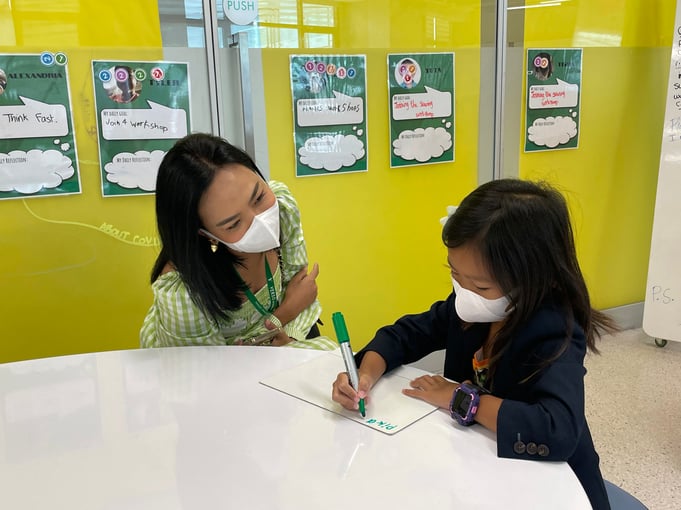10 Tips to Support Learning at Home
With everyone around the world socially and physically distancing themselves from people to minimize the spread of COVID-19, many schools are switching to distance learning through various methods. We are all in unprecedented territory and as an educator, it’s been heartening to see how schools and universities around the world are working collaboratively, sharing various online resources and content. The transition to distance learning can be challenging for families and here are my 10 tips on how parents can help build a productive distance learning environment.
#1 Be Flexible and Give Your Child Voice and Choice

Every day teachers make decisions based on each child’s age, prior skills and personality. They instinctively phrase questions differently or adjust time for an activity. Consider your child’s developmental level when planning for them. Better yet, plan WITH them. This is not the time to battle with them about sitting still or pressuring them to complete a task. Gauge their mood and allow for flexibility. Jobs of the future are more flexible and self-directed and this is a great time to build those skills. Remember to use your best judgment as you know your child best!
#2 Stay Active

We all know that physical activity is directly linked to our emotional and mental health. Find time for your child to move to relieve tension and have fun. Encourage older children to log their activity and track their moods. Use websites like GoNoodle or find online yoga sessions on YouTube. Take walks together and invite friends to participate in virtual fitness challenges that are currently trending such as a Fitbit Challenge or The Route 66 Virtual Fitness Challenge.
#10 Take it slow
#3 Build Communication Skills

Effective communication skills are a crucial future-ready skill. Don’t forget that building language skills incorporates reading, listening, speaking and writing. Take time reading as a family. We tend to stop reading to older children but they still love listening to stories. Ask distant friends and family to record themselves reading aloud. Audible has made their audio books for children free and many authors and celebrities have recorded stories online. This might be a good time to explore the world of podcasts. Listen to one listed here or think about recording one using a program like Anchor. Find writing opportunities for your child by sending thank you cards to health care professionals or writing stories to younger relatives. Most importantly, increase opportunities for conversation. Ever noticed how we pick up phrases that people around us use often? Research shows that this is the best way to expand vocabulary and further develop literacy skills. Use discussion prompts or start a question jar that everyone can contribute to. Ask questions about the stories that they are reading and try and make connections to their experiences.
#4 Play and Then Play Some More!

Games can be a fun way to learn together. A board game like Monopoly involves counting, decision-making and forming strategy. If you have children of different ages, try teaming together to allow for everyone to play. Card games help build math fluency. Don’t forget to allow time for your child to play alone. Activities like pretend play with dolls and figurines, building with LEGOs, and dress up allow for story building and fosters imagination. Play is an important part of emotional development. It builds emotional resilience, self-confidence, and reduces anxiety.
#5 Find Avenues for Creative Expression

Creative thinking is another important future-ready skill that contributes to a balanced life. Schools too often focus on academics. Use this time for your child to express themselves creatively. Photography challenges, such as 100 Happy Days, can be done with a smartphone. You may even create a book afterwards to document this interesting time in your child’s life. Famous illustrators are providing free online drawing lessons. Many orchestras like Seattle Symphony are also offering free broadcasts online and this is a good opportunity to introduce and expose children to various musical instruments.
#6 Feel the Feels

We can’t escape the fact that this is a time of uncertainty and fear. Many kids are experiencing anxiety about the virus and being sheltered at home. Just as our lives have been turned upside down, so has theirs. Try using an emotions chart as a way to express their feelings. This is a good time for your child to start journaling to process their emotions. You might think about making this a dialogue journal, one where you respond with questions or reassurances. This is great for families with multiple children, allowing you to provide the individual attention that might be challenging when everyone is at home. For easy management, designate a different day for each child for your response. I know a parent who started this when their child was younger and it proved to be valuable when the child became a teen. The teen would slip the journal to her parents when she had specific questions or concerns.
#7 Not All Screen Time Is the Same

You may be concerned about your child’s screen time. Not all screen time is equal so choose media content thoughtfully for your child. The content should be age-appropriate and set up clear rules for screen time together. Check Common Sense Media for reviews of movies, apps, games and TV shows. Use screen time to stay in touch with others and social interaction. Try playing a game or doing an activity together. Host an online talent show with different families using Zoom.
#10 Take it slow
#8 Learning Is Everywhere!

Take this time to help your children learn basic life skills. Cooking dinner is an opportunity to build skills like following recipes, measuring, exploring the origins of food or trying different cuisines. Laundry can become a sorting activity for young kids and a key skill for older kids before they head off to university. Ask questions and verbalize your steps, you will be amazed at how much they are learning from everyday tasks without a formal lesson.
#10 Take it slow
#9 Connect with Others

Now is the time to reach out and plan for more social connections. Being physically isolated does not mean that you have to be emotionally disconnected. Virtual playdates and birthday parties can be an alternative to being together in person. Try and find different ways to socialize with different people. Use social media together so you can teach your child about digital safty.
#10 Take it slow
#10 Take it slow

Give yourself and your family a break. It is perfectly fine to take some time off of your formal school routine. Kids (and adults) need time to adjust and trying to replicate everything may lead to frustration. Be flexible and agile. Your child will continue to learn, develop and grow. Yes, schools play a significant role in your child’s learning; however, this is a reminder that it is not the lessons in school that lead to your child’s learning. Instead, it is the social interactions, coaching by teachers and hands-on experiences that contribute to your child’s learning the most. Do what you can. Slow down and focus on what matters.
About Mihoko Chida:
Raised in the US, Mihoko started her teaching career in Southern California. Fluent in Japanese, she worked at Nishimachi International School in Tokyo for eight years, serving as the Curriculum Coordinator and the Elementary School Principal. She loves working in education because of her love for learning and enjoys being in a ‘job that allows you to be creative, solve problems, and forces you to think on your feet’. Mihoko is one of our founding Learning Designers and the G3-G4 Cohort Leader at our Lower Loop (Early Years 2 – Grade 4).
Click here to read more about our Learning Designers.
Tags: Parenting Tips









